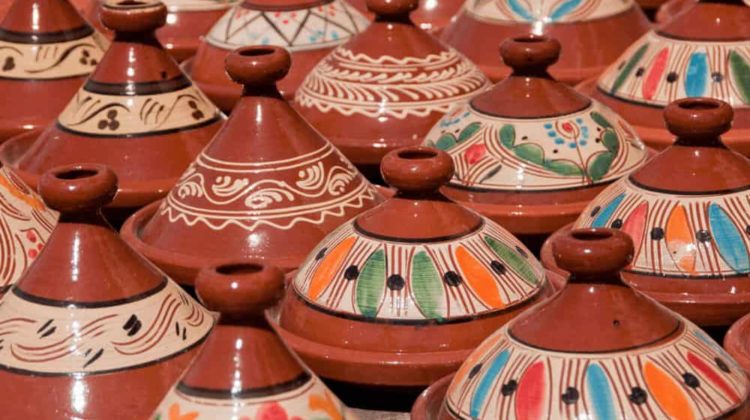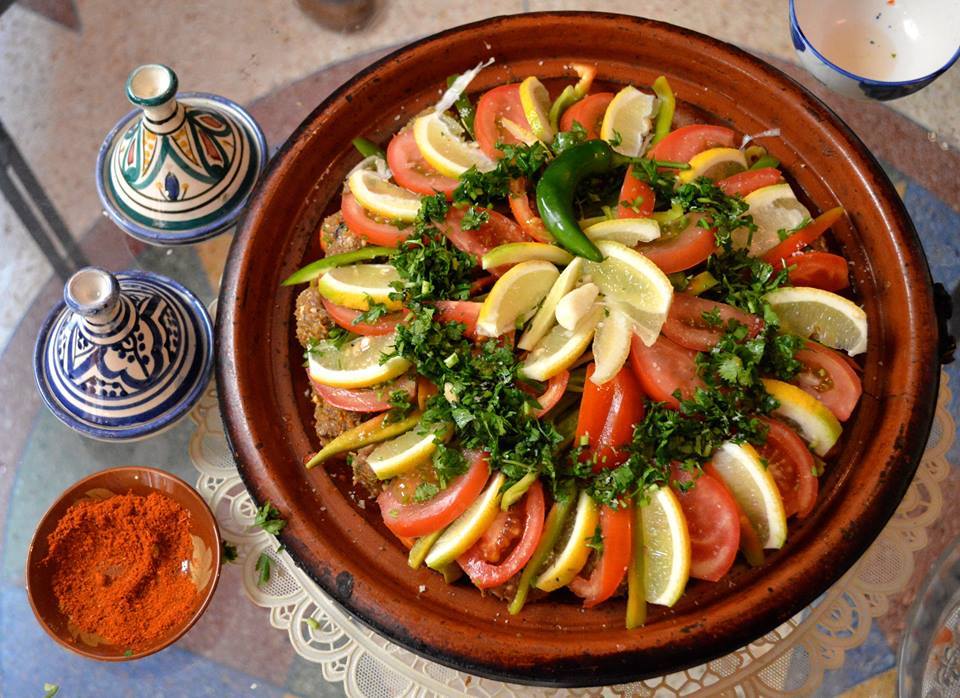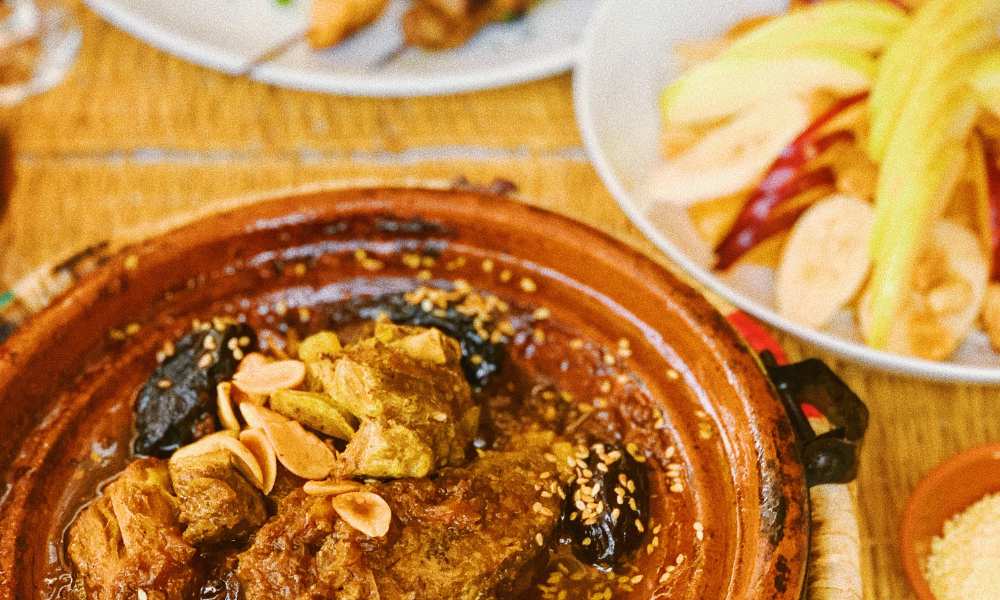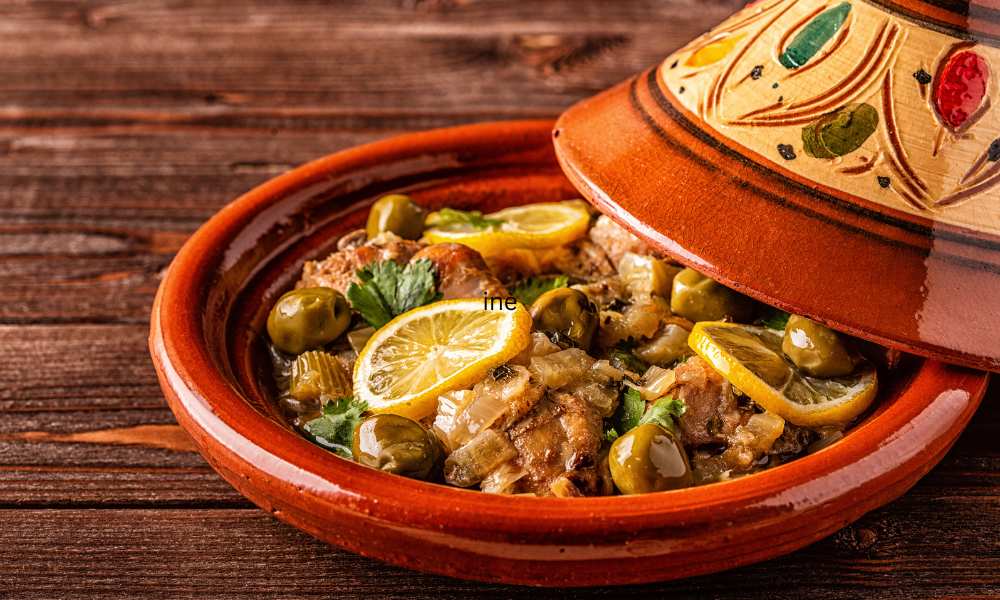
When you hear the word tagine, your brain instantly conjures up exotic images of colorful dishes cooking over coal or an open fire.
You can almost smell the scents steaming from the herbs and spices until it gently dissipates into the cold air.
There is definitely something poetic about the process of cooking a tagine, and something intimate about sharing one with friends and family.
So read along to find out more about the origins of the Moroccan tagine, what it is, and how to use it!
Some links below may be affiliate links. As an Amazon Associate I earn from qualifying purchases.
Table of Contents
The origins of the Moroccan tagine
The Moroccan tagine(also called tajine) has risen into popularity back in the Early Muslim conquests.
During Harun Al-Rashid’s rule in the 8th century, the traditional tagine has established itself as a staple dish.
Some early writings attribute the concept of the tagine to the Roman empire.
In fact, the idea stems from making a compact cooking vessel that’s easy enough to transport and travel with.
Some other accounts associate the prevalence of the Moroccan tagine with Berber culture.
Particularly considering how it served as a portable oven that Berber nomads, in the past, could easily take with them anywhere they went and conveniently cook food in.
The tagine also makes an appearance in the renowned folkloric masterpiece of ‘One thousand and one nights’ in the 9th century.
What is a Tagine?
If you’re not very familiar with Moroccan cuisine, chances are your definition of the word ‘tagine’ or ‘tajine’ is that of any other dish on the menu.

However. tagine does not only refer to the name of the plate but also the cookware itself
Traditionally placed on hot coals and open fires, a tagine is an earthenware pot typically made out of clay.
It is a two-piece set: the base of the tagine is round, wide and shallow. While the vessel’s cover is made into a conical shape with a sort of round knob at the peak.
The knob also serves as a handle to lift the cone and check on the food.
Why is the Moroccan Tagine Shaped that Way?
The conical shape of the tagine lid is not arbitrary or for decorative purposes only. It plays a key role in the preparation of this dish. While the food is cooking, steam rises into the cover due to the high heat.
After it is condensed on the lid and trapped inside, it falls back on the dish. Moisture retention is a crucial part of cooking tagine. It is what allows food in the base to cook evenly and release the different flavors into the pot.
All while the cover prevents the intricate aromas and flavors from escaping.
The slow cooking also plays a tremendous part in the process. It allows the ingredients to simmer and slightly caramelize while gently blending into one another.
This, in turn, makes the meat incredibly buttery as it bastes into the different juices. And the end result is of remarkable taste and exquisitely full of flavor.
Which Type of Tagine to Buy?
You can purchase a tagine at any roadside stall, bazaar or small shops in the ancient medinas of Morocco.
If you’re visiting, don’t miss out on the opportunity to acquire this exceptional utensil to add some culture into your kitchen.
If you’re not a fan of carrying a heavy tajine all the way back, you’ll find some great options online.
This 12.2” tagine is perfect for beginners and experts alike, it’s also 100% clay and lead-free.
If you prefer the matte finish to the glazed look, this handcrafted Moroccan tagine is the perfect option for you.
You should probably note that a lot of the ceramic pots and glazed ones are merely for decorative purposes.
Since they come in different colors and are embellished with various motifs and patterns, they’re hand-painted.
So you can serve your food in those plates but they’re not for cooking. This is just out of precaution, to avoid any residue paint contamination your food.
There are however some plain glazed tagines that you can cook your food in.
That’s in addition to the typical matte tagine pots made out of clay, which you can also use as earthenware for cooking and serving dishes.
Looking for a New Tagine for Your Kitchen? Check Out These Options:
How Do You Properly “Break in” Your Tagine?
What few people know is when you first buy a tagine, you need to “break it in” first. So you can’t directly cook in it until you do ‘maintenance’.
First, you submerge it in water for a couple of hours minimum. After it absorbs some of the water, you should clean out the excess moisture. Then let it stand for an additional hour to air dry.
After that, slather both the interior and exterior of the base and cone lid with some olive oil. Then put it in the oven and let it bake for approximately 2 hours at 300 F (or 150 celsius).
After it cools down, you can start using your tagine for cooking. Keep in mind that this seasoning process should be done every 6 months or so.
This process is necessary if you want to maintain the state of your tagine.
Not only does it strengthen your clay pot for future use, but it protects it from cracking under high heat.
Popular Moroccan Tagine Recipes
If you’re not making a vegetarian ‘7 vegetable tagine’ then you will find that most tagine recipes are centered around meat.
In fact, the type of meat to be used will dictate what spices, herbs, dried fruit, and vegetables to implement.

Some of the most popular variations of this exquisite dish are: lamb tagine with dried plums, fish tagine with chermoula (a tomato-based sauce with herbs, spices and chili pepper that serves as a filling for the fish), and chicken tagine with caramelized onions.
There are many colorful recipes to try depending on your skills and culinary expertise. You can always start with more beginner-friendly recipes that don’t require too many ingredients and build up from there.

The Food of Morocco and Tagines and Couscous are two great cookbooks to help you get started. You can also browse these 10 tagine recipes to see what appeals to you the most.
Ready to start cooking delicious Moroccan dishes?
Explore Moroccan Recipes on Amazon
Ready to discover the flavors of Morocco in your own kitchen? Check out these Moroccan recipe books available on Amazon



